Environmental Factors in Health Service and Facility Planning Report
VerifiedAdded on 2022/10/11
|17
|4779
|6
Report
AI Summary
This report provides an in-depth analysis of health service and facility planning, specifically focusing on the South Eastern Sydney Local Health District (SESLHD). It begins with an overview of the impact of population growth on healthcare needs and the implementation of the Local Health District (LHD) framework in South Eastern Wales. The report details the strategies employed by SESLHD to improve the health of the Australian population, highlighting the focus on chronic diseases and the provision of various services and technologies. The report emphasizes the importance of environmental scanning to identify factors affecting healthcare facilities, including both internal factors such as community health status and workforce, and external factors such as government policies, geography, and demography. It outlines various plans and strategies initiated by SESLHD, such as the journey to excellence strategy, community partnership strategy, and environmental sustainability plan, aiming to reduce death rates, promote healthy living, and address the needs of diverse populations, including Aboriginal communities and the homeless. The report concludes by emphasizing the role of environmental scans in improving service outcomes and patient satisfaction.
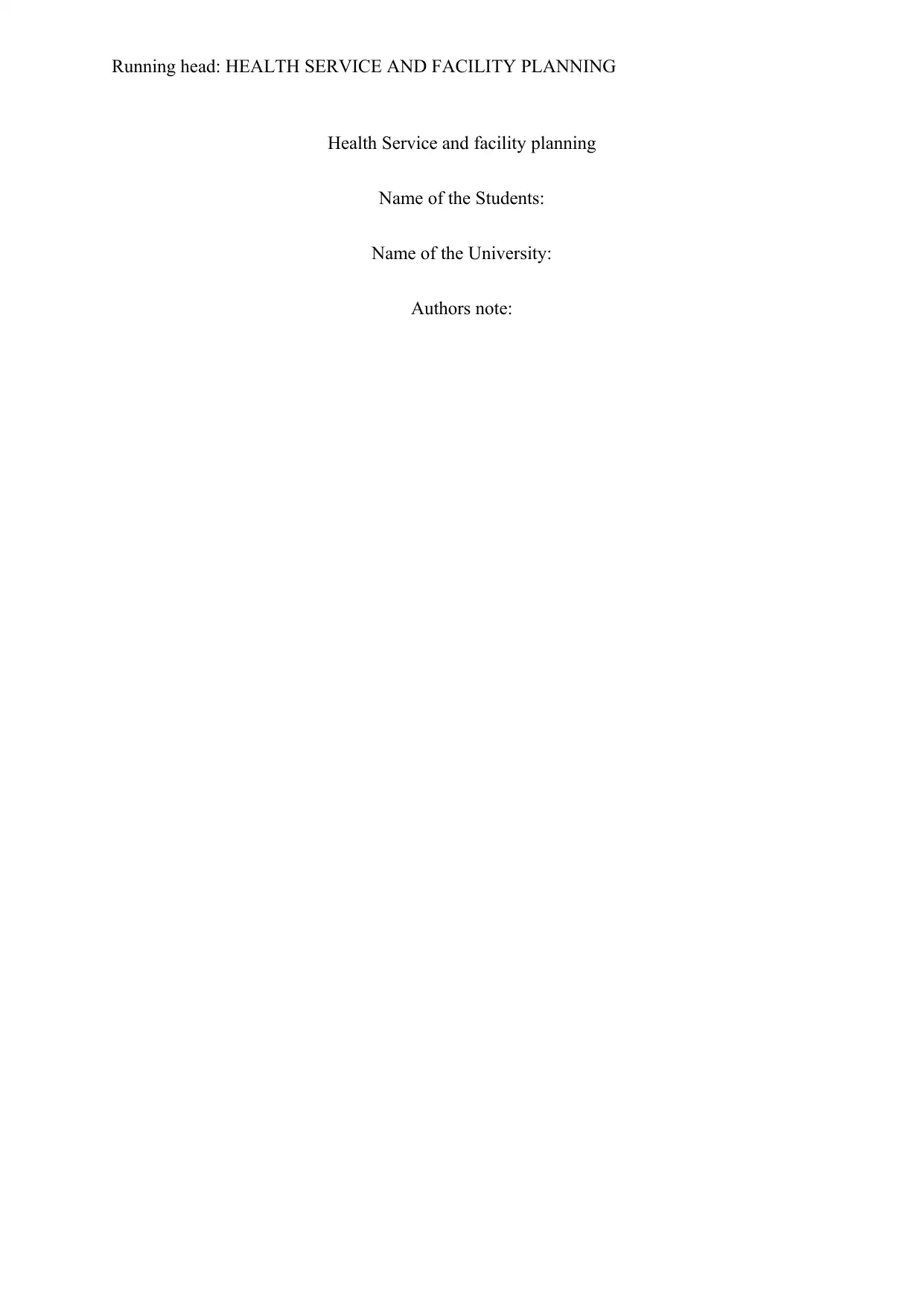
Running head: HEALTH SERVICE AND FACILITY PLANNING
Health Service and facility planning
Name of the Students:
Name of the University:
Authors note:
Health Service and facility planning
Name of the Students:
Name of the University:
Authors note:
Paraphrase This Document
Need a fresh take? Get an instant paraphrase of this document with our AI Paraphraser
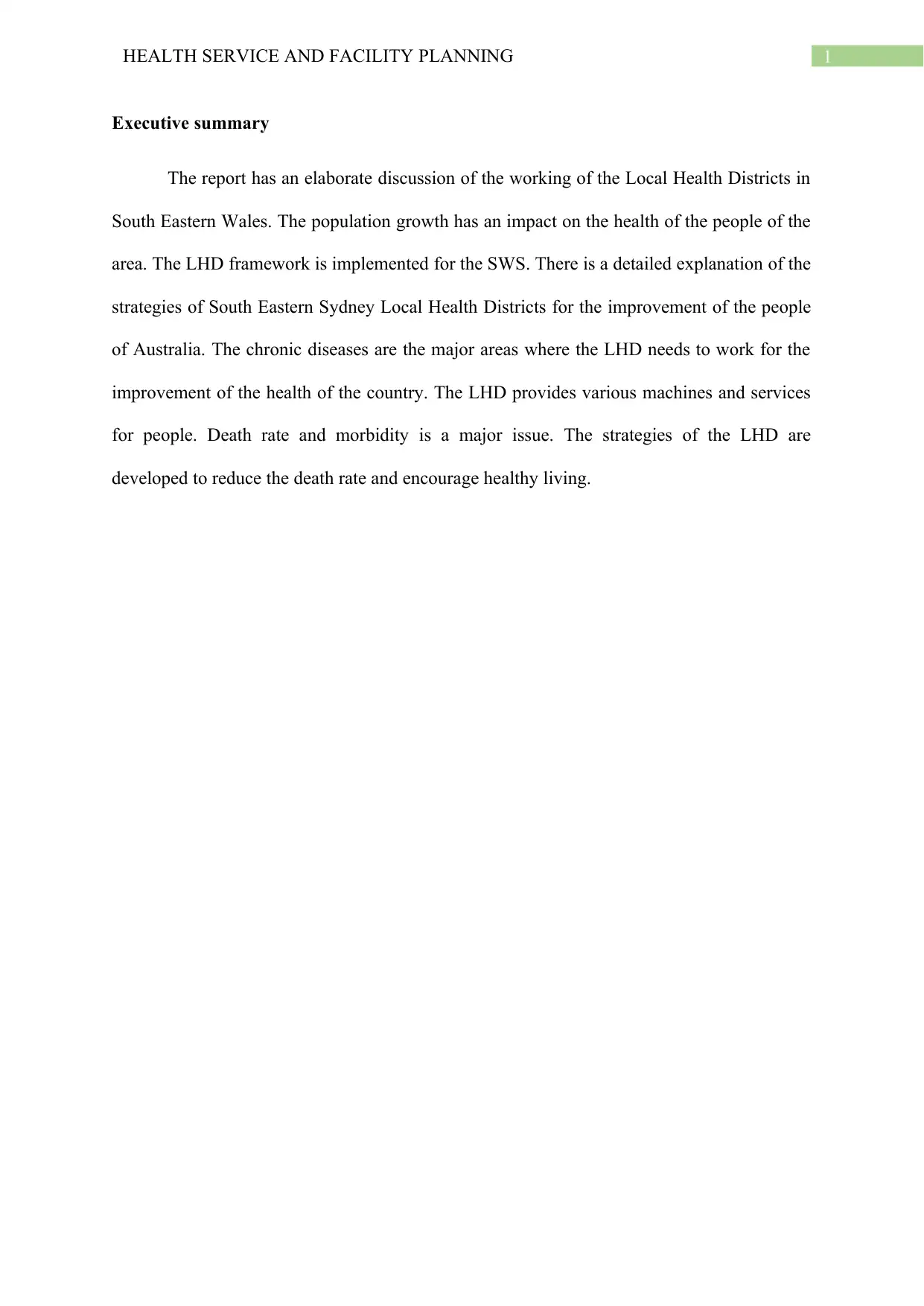
1HEALTH SERVICE AND FACILITY PLANNING
Executive summary
The report has an elaborate discussion of the working of the Local Health Districts in
South Eastern Wales. The population growth has an impact on the health of the people of the
area. The LHD framework is implemented for the SWS. There is a detailed explanation of the
strategies of South Eastern Sydney Local Health Districts for the improvement of the people
of Australia. The chronic diseases are the major areas where the LHD needs to work for the
improvement of the health of the country. The LHD provides various machines and services
for people. Death rate and morbidity is a major issue. The strategies of the LHD are
developed to reduce the death rate and encourage healthy living.
Executive summary
The report has an elaborate discussion of the working of the Local Health Districts in
South Eastern Wales. The population growth has an impact on the health of the people of the
area. The LHD framework is implemented for the SWS. There is a detailed explanation of the
strategies of South Eastern Sydney Local Health Districts for the improvement of the people
of Australia. The chronic diseases are the major areas where the LHD needs to work for the
improvement of the health of the country. The LHD provides various machines and services
for people. Death rate and morbidity is a major issue. The strategies of the LHD are
developed to reduce the death rate and encourage healthy living.
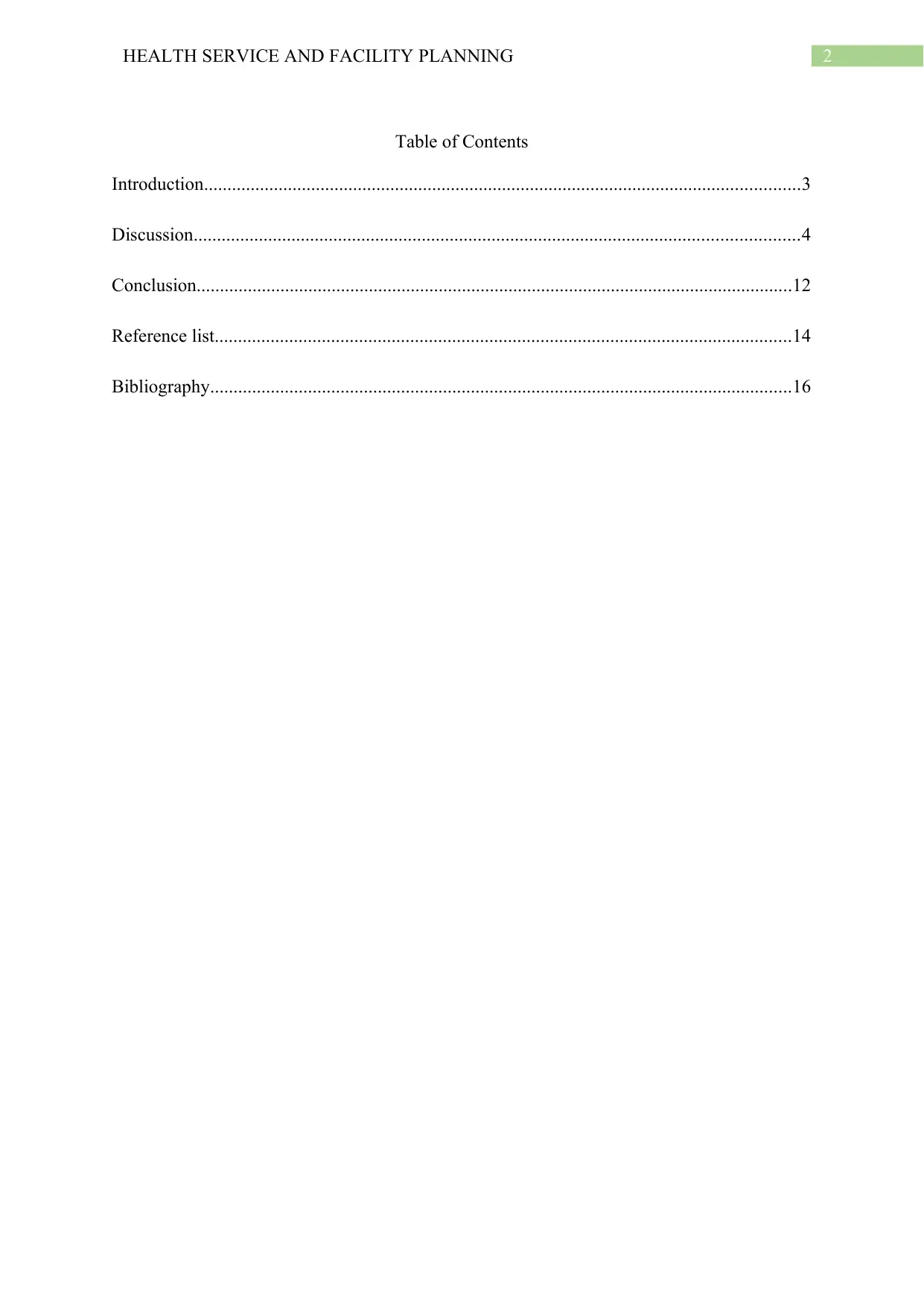
2HEALTH SERVICE AND FACILITY PLANNING
Table of Contents
Introduction................................................................................................................................3
Discussion..................................................................................................................................4
Conclusion................................................................................................................................12
Reference list............................................................................................................................14
Bibliography.............................................................................................................................16
Table of Contents
Introduction................................................................................................................................3
Discussion..................................................................................................................................4
Conclusion................................................................................................................................12
Reference list............................................................................................................................14
Bibliography.............................................................................................................................16
⊘ This is a preview!⊘
Do you want full access?
Subscribe today to unlock all pages.

Trusted by 1+ million students worldwide
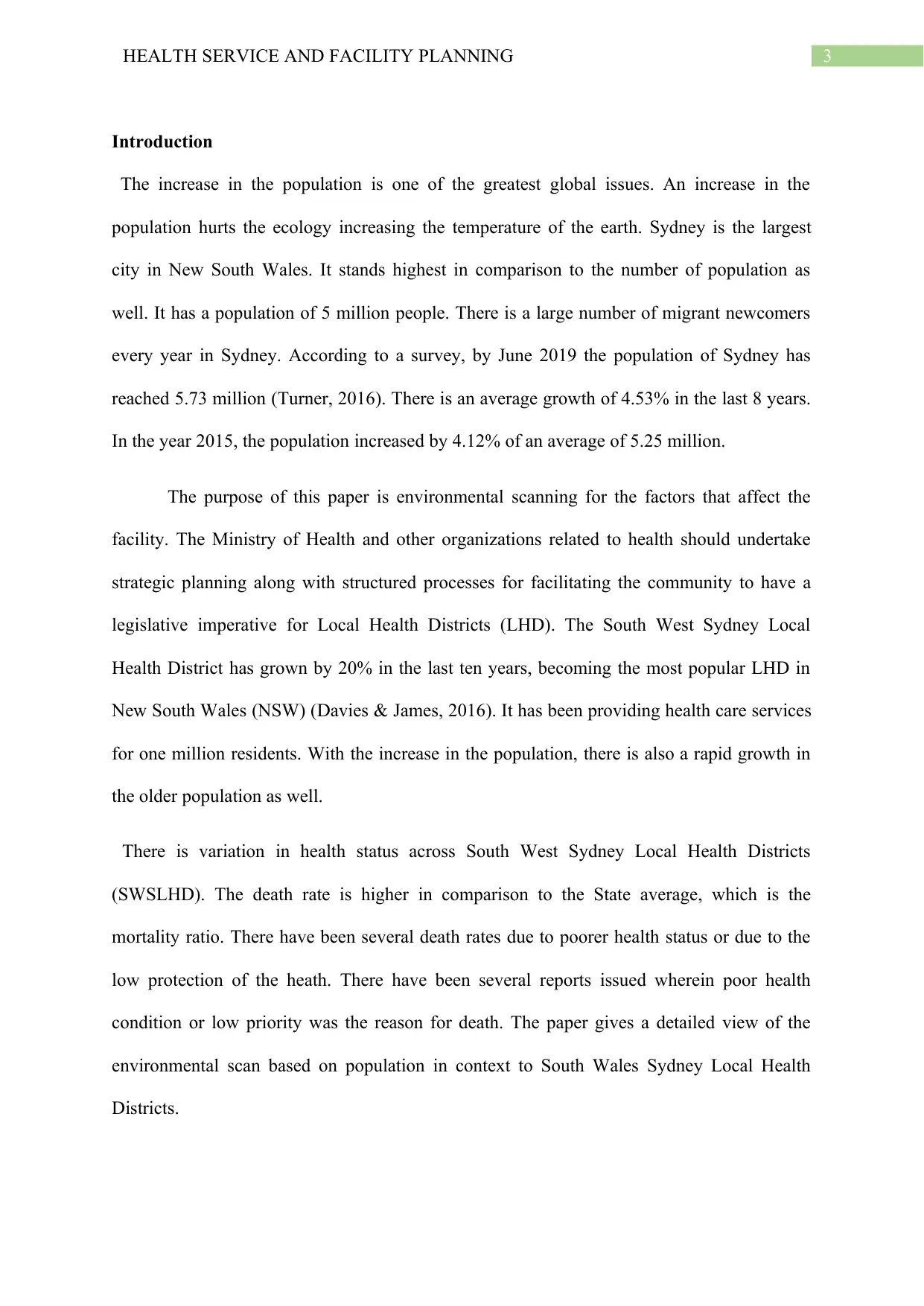
3HEALTH SERVICE AND FACILITY PLANNING
Introduction
The increase in the population is one of the greatest global issues. An increase in the
population hurts the ecology increasing the temperature of the earth. Sydney is the largest
city in New South Wales. It stands highest in comparison to the number of population as
well. It has a population of 5 million people. There is a large number of migrant newcomers
every year in Sydney. According to a survey, by June 2019 the population of Sydney has
reached 5.73 million (Turner, 2016). There is an average growth of 4.53% in the last 8 years.
In the year 2015, the population increased by 4.12% of an average of 5.25 million.
The purpose of this paper is environmental scanning for the factors that affect the
facility. The Ministry of Health and other organizations related to health should undertake
strategic planning along with structured processes for facilitating the community to have a
legislative imperative for Local Health Districts (LHD). The South West Sydney Local
Health District has grown by 20% in the last ten years, becoming the most popular LHD in
New South Wales (NSW) (Davies & James, 2016). It has been providing health care services
for one million residents. With the increase in the population, there is also a rapid growth in
the older population as well.
There is variation in health status across South West Sydney Local Health Districts
(SWSLHD). The death rate is higher in comparison to the State average, which is the
mortality ratio. There have been several death rates due to poorer health status or due to the
low protection of the heath. There have been several reports issued wherein poor health
condition or low priority was the reason for death. The paper gives a detailed view of the
environmental scan based on population in context to South Wales Sydney Local Health
Districts.
Introduction
The increase in the population is one of the greatest global issues. An increase in the
population hurts the ecology increasing the temperature of the earth. Sydney is the largest
city in New South Wales. It stands highest in comparison to the number of population as
well. It has a population of 5 million people. There is a large number of migrant newcomers
every year in Sydney. According to a survey, by June 2019 the population of Sydney has
reached 5.73 million (Turner, 2016). There is an average growth of 4.53% in the last 8 years.
In the year 2015, the population increased by 4.12% of an average of 5.25 million.
The purpose of this paper is environmental scanning for the factors that affect the
facility. The Ministry of Health and other organizations related to health should undertake
strategic planning along with structured processes for facilitating the community to have a
legislative imperative for Local Health Districts (LHD). The South West Sydney Local
Health District has grown by 20% in the last ten years, becoming the most popular LHD in
New South Wales (NSW) (Davies & James, 2016). It has been providing health care services
for one million residents. With the increase in the population, there is also a rapid growth in
the older population as well.
There is variation in health status across South West Sydney Local Health Districts
(SWSLHD). The death rate is higher in comparison to the State average, which is the
mortality ratio. There have been several death rates due to poorer health status or due to the
low protection of the heath. There have been several reports issued wherein poor health
condition or low priority was the reason for death. The paper gives a detailed view of the
environmental scan based on population in context to South Wales Sydney Local Health
Districts.
Paraphrase This Document
Need a fresh take? Get an instant paraphrase of this document with our AI Paraphraser
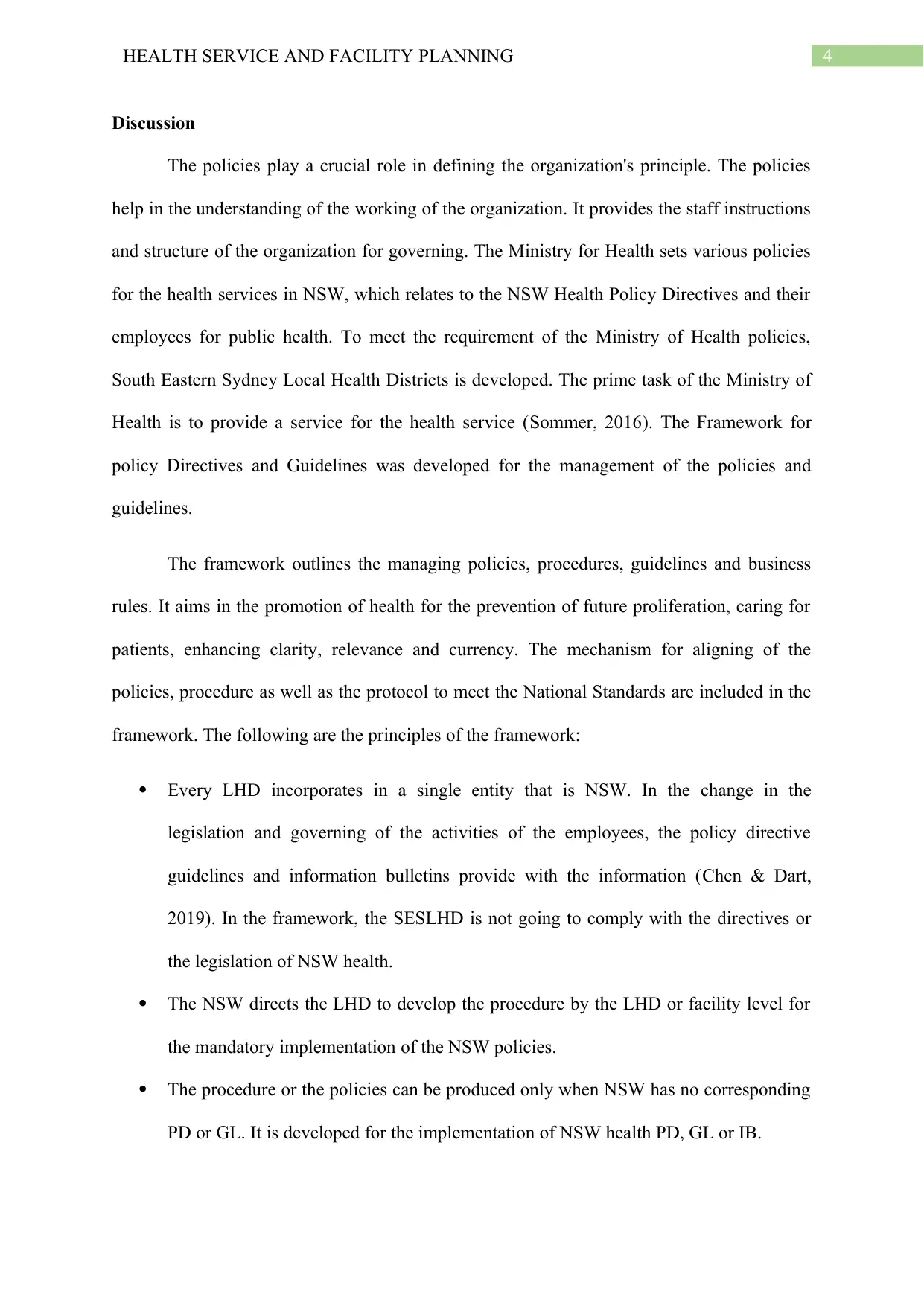
4HEALTH SERVICE AND FACILITY PLANNING
Discussion
The policies play a crucial role in defining the organization's principle. The policies
help in the understanding of the working of the organization. It provides the staff instructions
and structure of the organization for governing. The Ministry for Health sets various policies
for the health services in NSW, which relates to the NSW Health Policy Directives and their
employees for public health. To meet the requirement of the Ministry of Health policies,
South Eastern Sydney Local Health Districts is developed. The prime task of the Ministry of
Health is to provide a service for the health service (Sommer, 2016). The Framework for
policy Directives and Guidelines was developed for the management of the policies and
guidelines.
The framework outlines the managing policies, procedures, guidelines and business
rules. It aims in the promotion of health for the prevention of future proliferation, caring for
patients, enhancing clarity, relevance and currency. The mechanism for aligning of the
policies, procedure as well as the protocol to meet the National Standards are included in the
framework. The following are the principles of the framework:
Every LHD incorporates in a single entity that is NSW. In the change in the
legislation and governing of the activities of the employees, the policy directive
guidelines and information bulletins provide with the information (Chen & Dart,
2019). In the framework, the SESLHD is not going to comply with the directives or
the legislation of NSW health.
The NSW directs the LHD to develop the procedure by the LHD or facility level for
the mandatory implementation of the NSW policies.
The procedure or the policies can be produced only when NSW has no corresponding
PD or GL. It is developed for the implementation of NSW health PD, GL or IB.
Discussion
The policies play a crucial role in defining the organization's principle. The policies
help in the understanding of the working of the organization. It provides the staff instructions
and structure of the organization for governing. The Ministry for Health sets various policies
for the health services in NSW, which relates to the NSW Health Policy Directives and their
employees for public health. To meet the requirement of the Ministry of Health policies,
South Eastern Sydney Local Health Districts is developed. The prime task of the Ministry of
Health is to provide a service for the health service (Sommer, 2016). The Framework for
policy Directives and Guidelines was developed for the management of the policies and
guidelines.
The framework outlines the managing policies, procedures, guidelines and business
rules. It aims in the promotion of health for the prevention of future proliferation, caring for
patients, enhancing clarity, relevance and currency. The mechanism for aligning of the
policies, procedure as well as the protocol to meet the National Standards are included in the
framework. The following are the principles of the framework:
Every LHD incorporates in a single entity that is NSW. In the change in the
legislation and governing of the activities of the employees, the policy directive
guidelines and information bulletins provide with the information (Chen & Dart,
2019). In the framework, the SESLHD is not going to comply with the directives or
the legislation of NSW health.
The NSW directs the LHD to develop the procedure by the LHD or facility level for
the mandatory implementation of the NSW policies.
The procedure or the policies can be produced only when NSW has no corresponding
PD or GL. It is developed for the implementation of NSW health PD, GL or IB.
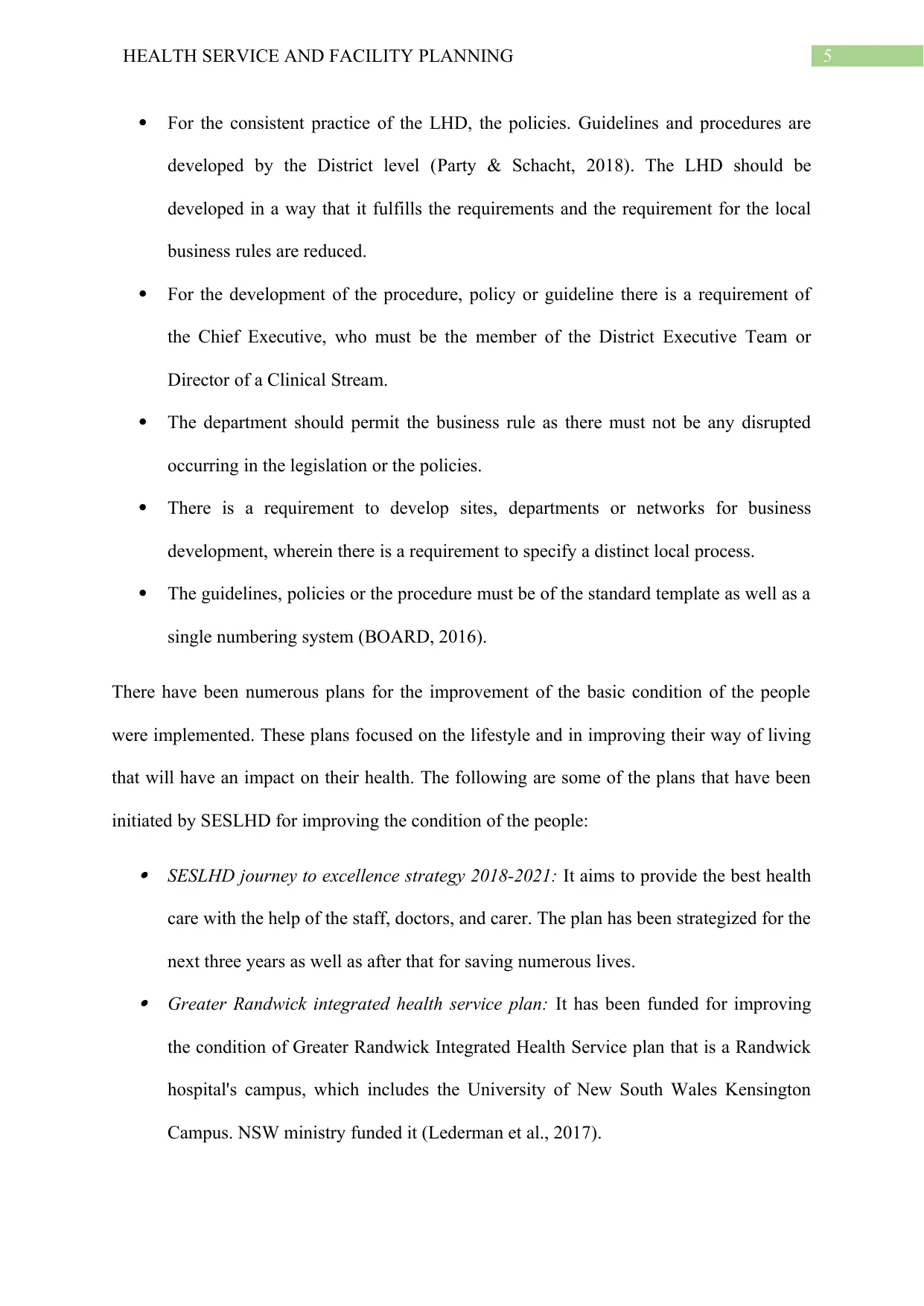
5HEALTH SERVICE AND FACILITY PLANNING
For the consistent practice of the LHD, the policies. Guidelines and procedures are
developed by the District level (Party & Schacht, 2018). The LHD should be
developed in a way that it fulfills the requirements and the requirement for the local
business rules are reduced.
For the development of the procedure, policy or guideline there is a requirement of
the Chief Executive, who must be the member of the District Executive Team or
Director of a Clinical Stream.
The department should permit the business rule as there must not be any disrupted
occurring in the legislation or the policies.
There is a requirement to develop sites, departments or networks for business
development, wherein there is a requirement to specify a distinct local process.
The guidelines, policies or the procedure must be of the standard template as well as a
single numbering system (BOARD, 2016).
There have been numerous plans for the improvement of the basic condition of the people
were implemented. These plans focused on the lifestyle and in improving their way of living
that will have an impact on their health. The following are some of the plans that have been
initiated by SESLHD for improving the condition of the people:
SESLHD journey to excellence strategy 2018-2021: It aims to provide the best health
care with the help of the staff, doctors, and carer. The plan has been strategized for the
next three years as well as after that for saving numerous lives. Greater Randwick integrated health service plan: It has been funded for improving
the condition of Greater Randwick Integrated Health Service plan that is a Randwick
hospital's campus, which includes the University of New South Wales Kensington
Campus. NSW ministry funded it (Lederman et al., 2017).
For the consistent practice of the LHD, the policies. Guidelines and procedures are
developed by the District level (Party & Schacht, 2018). The LHD should be
developed in a way that it fulfills the requirements and the requirement for the local
business rules are reduced.
For the development of the procedure, policy or guideline there is a requirement of
the Chief Executive, who must be the member of the District Executive Team or
Director of a Clinical Stream.
The department should permit the business rule as there must not be any disrupted
occurring in the legislation or the policies.
There is a requirement to develop sites, departments or networks for business
development, wherein there is a requirement to specify a distinct local process.
The guidelines, policies or the procedure must be of the standard template as well as a
single numbering system (BOARD, 2016).
There have been numerous plans for the improvement of the basic condition of the people
were implemented. These plans focused on the lifestyle and in improving their way of living
that will have an impact on their health. The following are some of the plans that have been
initiated by SESLHD for improving the condition of the people:
SESLHD journey to excellence strategy 2018-2021: It aims to provide the best health
care with the help of the staff, doctors, and carer. The plan has been strategized for the
next three years as well as after that for saving numerous lives. Greater Randwick integrated health service plan: It has been funded for improving
the condition of Greater Randwick Integrated Health Service plan that is a Randwick
hospital's campus, which includes the University of New South Wales Kensington
Campus. NSW ministry funded it (Lederman et al., 2017).
⊘ This is a preview!⊘
Do you want full access?
Subscribe today to unlock all pages.

Trusted by 1+ million students worldwide
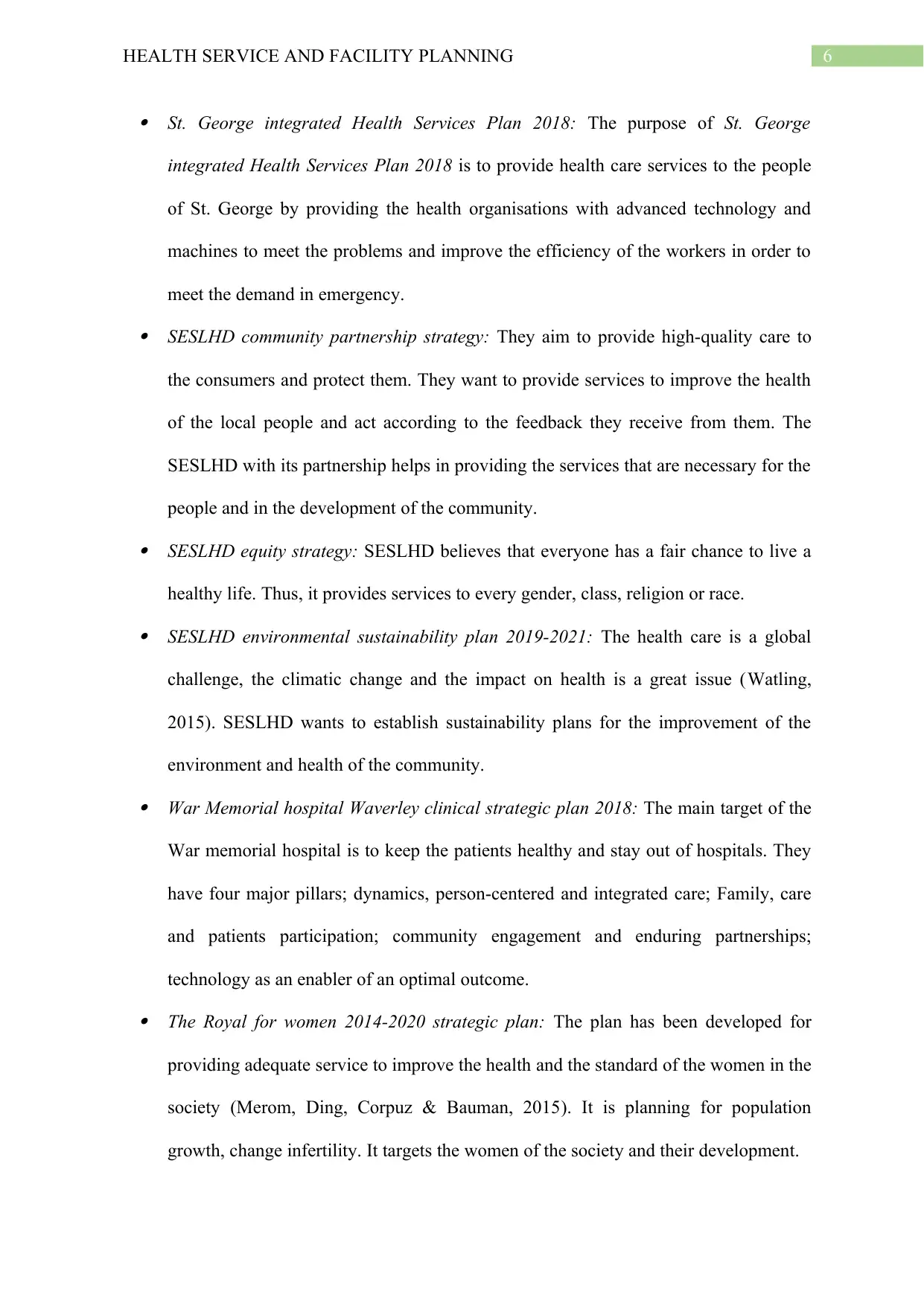
6HEALTH SERVICE AND FACILITY PLANNING
St. George integrated Health Services Plan 2018: The purpose of St. George
integrated Health Services Plan 2018 is to provide health care services to the people
of St. George by providing the health organisations with advanced technology and
machines to meet the problems and improve the efficiency of the workers in order to
meet the demand in emergency. SESLHD community partnership strategy: They aim to provide high-quality care to
the consumers and protect them. They want to provide services to improve the health
of the local people and act according to the feedback they receive from them. The
SESLHD with its partnership helps in providing the services that are necessary for the
people and in the development of the community. SESLHD equity strategy: SESLHD believes that everyone has a fair chance to live a
healthy life. Thus, it provides services to every gender, class, religion or race. SESLHD environmental sustainability plan 2019-2021: The health care is a global
challenge, the climatic change and the impact on health is a great issue (Watling,
2015). SESLHD wants to establish sustainability plans for the improvement of the
environment and health of the community. War Memorial hospital Waverley clinical strategic plan 2018: The main target of the
War memorial hospital is to keep the patients healthy and stay out of hospitals. They
have four major pillars; dynamics, person-centered and integrated care; Family, care
and patients participation; community engagement and enduring partnerships;
technology as an enabler of an optimal outcome. The Royal for women 2014-2020 strategic plan: The plan has been developed for
providing adequate service to improve the health and the standard of the women in the
society (Merom, Ding, Corpuz & Bauman, 2015). It is planning for population
growth, change infertility. It targets the women of the society and their development.
St. George integrated Health Services Plan 2018: The purpose of St. George
integrated Health Services Plan 2018 is to provide health care services to the people
of St. George by providing the health organisations with advanced technology and
machines to meet the problems and improve the efficiency of the workers in order to
meet the demand in emergency. SESLHD community partnership strategy: They aim to provide high-quality care to
the consumers and protect them. They want to provide services to improve the health
of the local people and act according to the feedback they receive from them. The
SESLHD with its partnership helps in providing the services that are necessary for the
people and in the development of the community. SESLHD equity strategy: SESLHD believes that everyone has a fair chance to live a
healthy life. Thus, it provides services to every gender, class, religion or race. SESLHD environmental sustainability plan 2019-2021: The health care is a global
challenge, the climatic change and the impact on health is a great issue (Watling,
2015). SESLHD wants to establish sustainability plans for the improvement of the
environment and health of the community. War Memorial hospital Waverley clinical strategic plan 2018: The main target of the
War memorial hospital is to keep the patients healthy and stay out of hospitals. They
have four major pillars; dynamics, person-centered and integrated care; Family, care
and patients participation; community engagement and enduring partnerships;
technology as an enabler of an optimal outcome. The Royal for women 2014-2020 strategic plan: The plan has been developed for
providing adequate service to improve the health and the standard of the women in the
society (Merom, Ding, Corpuz & Bauman, 2015). It is planning for population
growth, change infertility. It targets the women of the society and their development.
Paraphrase This Document
Need a fresh take? Get an instant paraphrase of this document with our AI Paraphraser
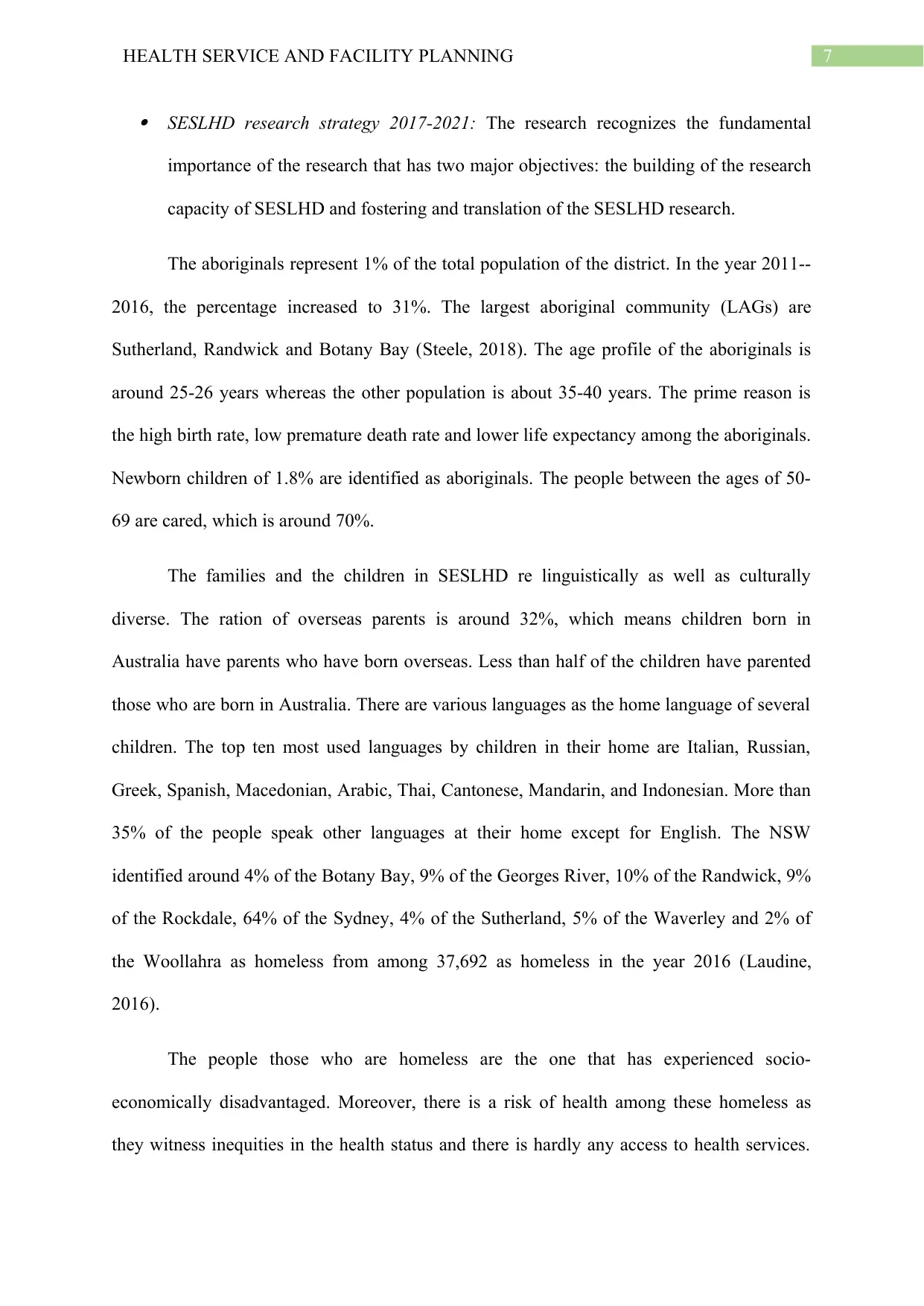
7HEALTH SERVICE AND FACILITY PLANNING
SESLHD research strategy 2017-2021: The research recognizes the fundamental
importance of the research that has two major objectives: the building of the research
capacity of SESLHD and fostering and translation of the SESLHD research.
The aboriginals represent 1% of the total population of the district. In the year 2011--
2016, the percentage increased to 31%. The largest aboriginal community (LAGs) are
Sutherland, Randwick and Botany Bay (Steele, 2018). The age profile of the aboriginals is
around 25-26 years whereas the other population is about 35-40 years. The prime reason is
the high birth rate, low premature death rate and lower life expectancy among the aboriginals.
Newborn children of 1.8% are identified as aboriginals. The people between the ages of 50-
69 are cared, which is around 70%.
The families and the children in SESLHD re linguistically as well as culturally
diverse. The ration of overseas parents is around 32%, which means children born in
Australia have parents who have born overseas. Less than half of the children have parented
those who are born in Australia. There are various languages as the home language of several
children. The top ten most used languages by children in their home are Italian, Russian,
Greek, Spanish, Macedonian, Arabic, Thai, Cantonese, Mandarin, and Indonesian. More than
35% of the people speak other languages at their home except for English. The NSW
identified around 4% of the Botany Bay, 9% of the Georges River, 10% of the Randwick, 9%
of the Rockdale, 64% of the Sydney, 4% of the Sutherland, 5% of the Waverley and 2% of
the Woollahra as homeless from among 37,692 as homeless in the year 2016 (Laudine,
2016).
The people those who are homeless are the one that has experienced socio-
economically disadvantaged. Moreover, there is a risk of health among these homeless as
they witness inequities in the health status and there is hardly any access to health services.
SESLHD research strategy 2017-2021: The research recognizes the fundamental
importance of the research that has two major objectives: the building of the research
capacity of SESLHD and fostering and translation of the SESLHD research.
The aboriginals represent 1% of the total population of the district. In the year 2011--
2016, the percentage increased to 31%. The largest aboriginal community (LAGs) are
Sutherland, Randwick and Botany Bay (Steele, 2018). The age profile of the aboriginals is
around 25-26 years whereas the other population is about 35-40 years. The prime reason is
the high birth rate, low premature death rate and lower life expectancy among the aboriginals.
Newborn children of 1.8% are identified as aboriginals. The people between the ages of 50-
69 are cared, which is around 70%.
The families and the children in SESLHD re linguistically as well as culturally
diverse. The ration of overseas parents is around 32%, which means children born in
Australia have parents who have born overseas. Less than half of the children have parented
those who are born in Australia. There are various languages as the home language of several
children. The top ten most used languages by children in their home are Italian, Russian,
Greek, Spanish, Macedonian, Arabic, Thai, Cantonese, Mandarin, and Indonesian. More than
35% of the people speak other languages at their home except for English. The NSW
identified around 4% of the Botany Bay, 9% of the Georges River, 10% of the Randwick, 9%
of the Rockdale, 64% of the Sydney, 4% of the Sutherland, 5% of the Waverley and 2% of
the Woollahra as homeless from among 37,692 as homeless in the year 2016 (Laudine,
2016).
The people those who are homeless are the one that has experienced socio-
economically disadvantaged. Moreover, there is a risk of health among these homeless as
they witness inequities in the health status and there is hardly any access to health services.
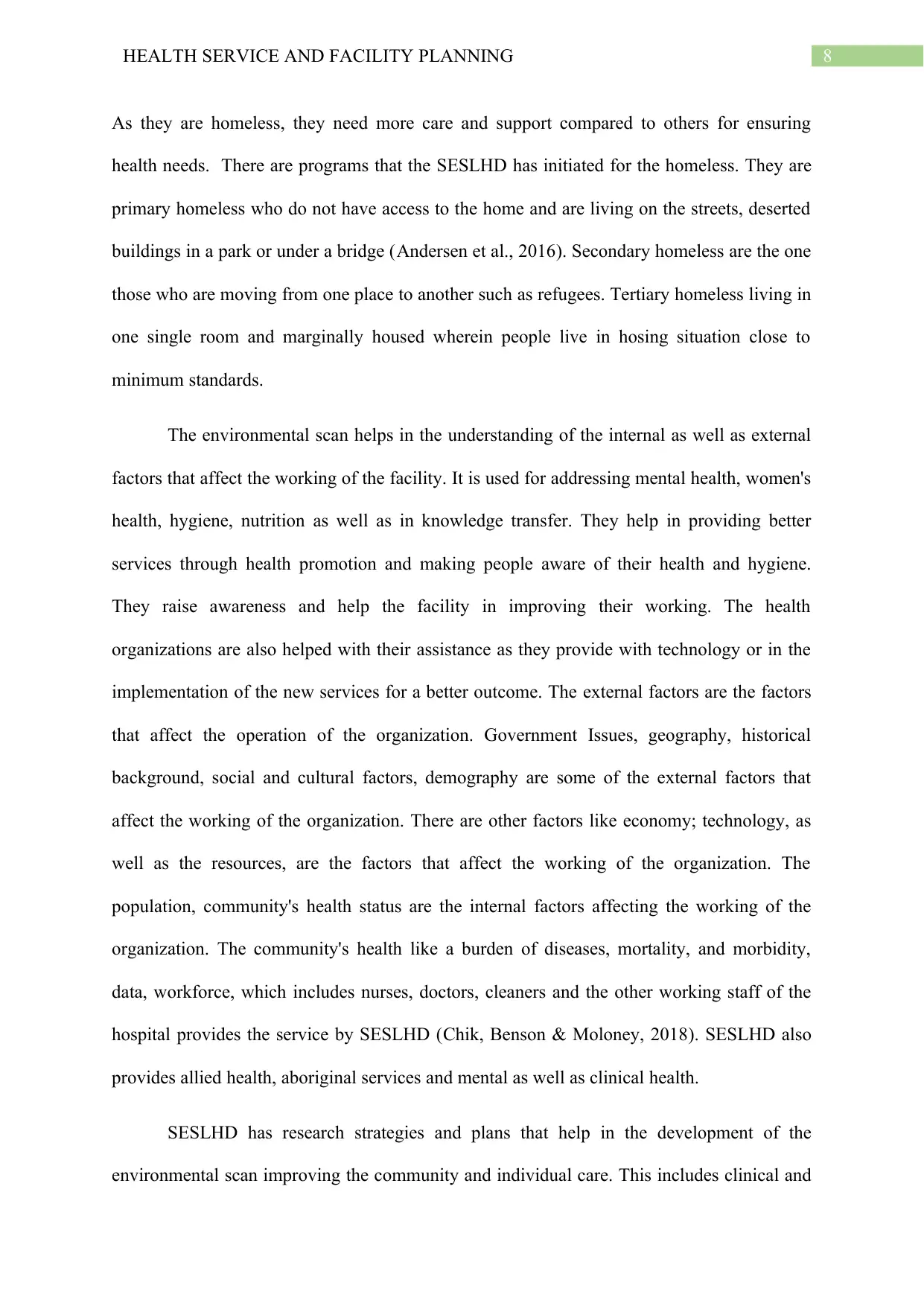
8HEALTH SERVICE AND FACILITY PLANNING
As they are homeless, they need more care and support compared to others for ensuring
health needs. There are programs that the SESLHD has initiated for the homeless. They are
primary homeless who do not have access to the home and are living on the streets, deserted
buildings in a park or under a bridge (Andersen et al., 2016). Secondary homeless are the one
those who are moving from one place to another such as refugees. Tertiary homeless living in
one single room and marginally housed wherein people live in hosing situation close to
minimum standards.
The environmental scan helps in the understanding of the internal as well as external
factors that affect the working of the facility. It is used for addressing mental health, women's
health, hygiene, nutrition as well as in knowledge transfer. They help in providing better
services through health promotion and making people aware of their health and hygiene.
They raise awareness and help the facility in improving their working. The health
organizations are also helped with their assistance as they provide with technology or in the
implementation of the new services for a better outcome. The external factors are the factors
that affect the operation of the organization. Government Issues, geography, historical
background, social and cultural factors, demography are some of the external factors that
affect the working of the organization. There are other factors like economy; technology, as
well as the resources, are the factors that affect the working of the organization. The
population, community's health status are the internal factors affecting the working of the
organization. The community's health like a burden of diseases, mortality, and morbidity,
data, workforce, which includes nurses, doctors, cleaners and the other working staff of the
hospital provides the service by SESLHD (Chik, Benson & Moloney, 2018). SESLHD also
provides allied health, aboriginal services and mental as well as clinical health.
SESLHD has research strategies and plans that help in the development of the
environmental scan improving the community and individual care. This includes clinical and
As they are homeless, they need more care and support compared to others for ensuring
health needs. There are programs that the SESLHD has initiated for the homeless. They are
primary homeless who do not have access to the home and are living on the streets, deserted
buildings in a park or under a bridge (Andersen et al., 2016). Secondary homeless are the one
those who are moving from one place to another such as refugees. Tertiary homeless living in
one single room and marginally housed wherein people live in hosing situation close to
minimum standards.
The environmental scan helps in the understanding of the internal as well as external
factors that affect the working of the facility. It is used for addressing mental health, women's
health, hygiene, nutrition as well as in knowledge transfer. They help in providing better
services through health promotion and making people aware of their health and hygiene.
They raise awareness and help the facility in improving their working. The health
organizations are also helped with their assistance as they provide with technology or in the
implementation of the new services for a better outcome. The external factors are the factors
that affect the operation of the organization. Government Issues, geography, historical
background, social and cultural factors, demography are some of the external factors that
affect the working of the organization. There are other factors like economy; technology, as
well as the resources, are the factors that affect the working of the organization. The
population, community's health status are the internal factors affecting the working of the
organization. The community's health like a burden of diseases, mortality, and morbidity,
data, workforce, which includes nurses, doctors, cleaners and the other working staff of the
hospital provides the service by SESLHD (Chik, Benson & Moloney, 2018). SESLHD also
provides allied health, aboriginal services and mental as well as clinical health.
SESLHD has research strategies and plans that help in the development of the
environmental scan improving the community and individual care. This includes clinical and
⊘ This is a preview!⊘
Do you want full access?
Subscribe today to unlock all pages.

Trusted by 1+ million students worldwide
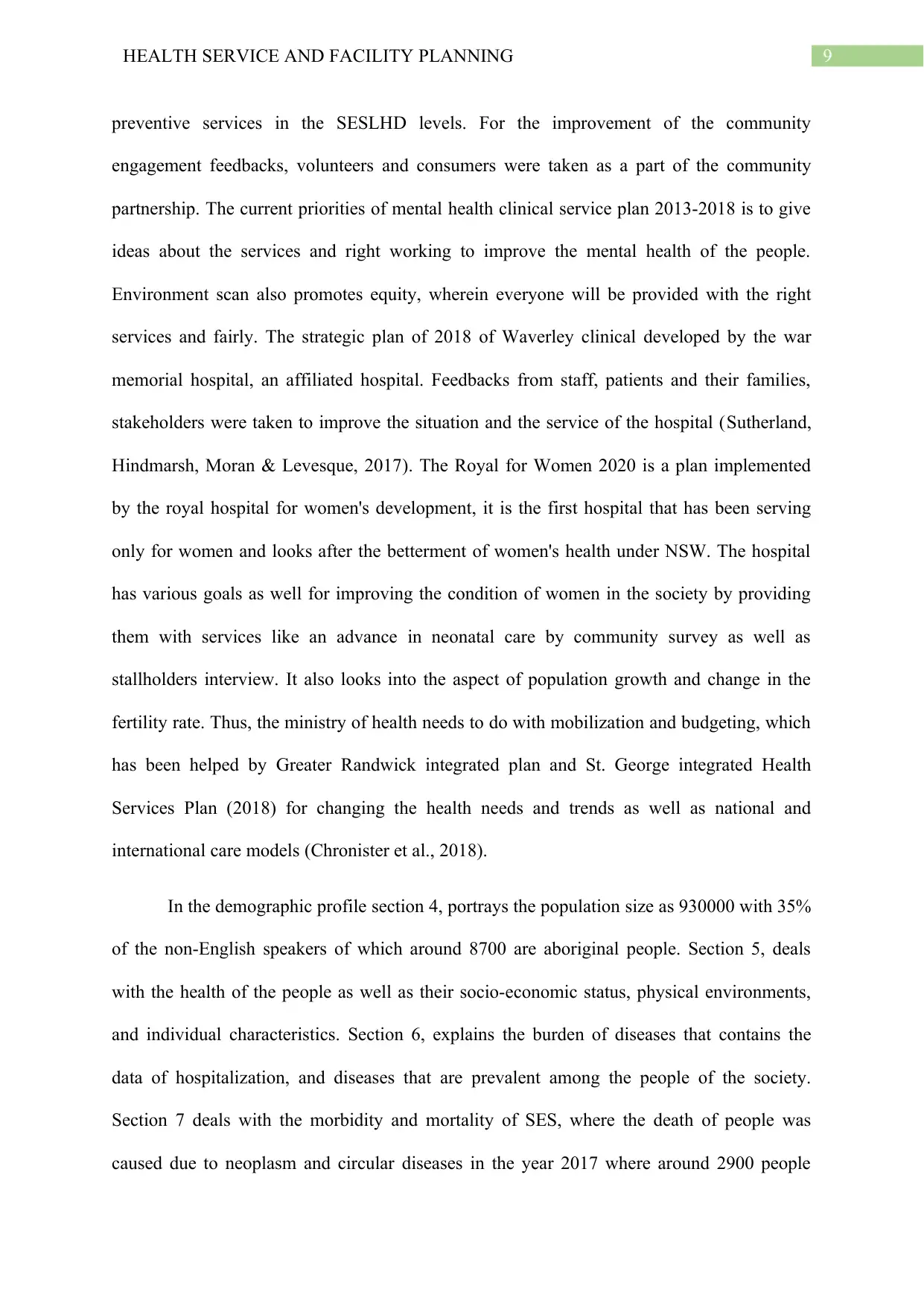
9HEALTH SERVICE AND FACILITY PLANNING
preventive services in the SESLHD levels. For the improvement of the community
engagement feedbacks, volunteers and consumers were taken as a part of the community
partnership. The current priorities of mental health clinical service plan 2013-2018 is to give
ideas about the services and right working to improve the mental health of the people.
Environment scan also promotes equity, wherein everyone will be provided with the right
services and fairly. The strategic plan of 2018 of Waverley clinical developed by the war
memorial hospital, an affiliated hospital. Feedbacks from staff, patients and their families,
stakeholders were taken to improve the situation and the service of the hospital (Sutherland,
Hindmarsh, Moran & Levesque, 2017). The Royal for Women 2020 is a plan implemented
by the royal hospital for women's development, it is the first hospital that has been serving
only for women and looks after the betterment of women's health under NSW. The hospital
has various goals as well for improving the condition of women in the society by providing
them with services like an advance in neonatal care by community survey as well as
stallholders interview. It also looks into the aspect of population growth and change in the
fertility rate. Thus, the ministry of health needs to do with mobilization and budgeting, which
has been helped by Greater Randwick integrated plan and St. George integrated Health
Services Plan (2018) for changing the health needs and trends as well as national and
international care models (Chronister et al., 2018).
In the demographic profile section 4, portrays the population size as 930000 with 35%
of the non-English speakers of which around 8700 are aboriginal people. Section 5, deals
with the health of the people as well as their socio-economic status, physical environments,
and individual characteristics. Section 6, explains the burden of diseases that contains the
data of hospitalization, and diseases that are prevalent among the people of the society.
Section 7 deals with the morbidity and mortality of SES, where the death of people was
caused due to neoplasm and circular diseases in the year 2017 where around 2900 people
preventive services in the SESLHD levels. For the improvement of the community
engagement feedbacks, volunteers and consumers were taken as a part of the community
partnership. The current priorities of mental health clinical service plan 2013-2018 is to give
ideas about the services and right working to improve the mental health of the people.
Environment scan also promotes equity, wherein everyone will be provided with the right
services and fairly. The strategic plan of 2018 of Waverley clinical developed by the war
memorial hospital, an affiliated hospital. Feedbacks from staff, patients and their families,
stakeholders were taken to improve the situation and the service of the hospital (Sutherland,
Hindmarsh, Moran & Levesque, 2017). The Royal for Women 2020 is a plan implemented
by the royal hospital for women's development, it is the first hospital that has been serving
only for women and looks after the betterment of women's health under NSW. The hospital
has various goals as well for improving the condition of women in the society by providing
them with services like an advance in neonatal care by community survey as well as
stallholders interview. It also looks into the aspect of population growth and change in the
fertility rate. Thus, the ministry of health needs to do with mobilization and budgeting, which
has been helped by Greater Randwick integrated plan and St. George integrated Health
Services Plan (2018) for changing the health needs and trends as well as national and
international care models (Chronister et al., 2018).
In the demographic profile section 4, portrays the population size as 930000 with 35%
of the non-English speakers of which around 8700 are aboriginal people. Section 5, deals
with the health of the people as well as their socio-economic status, physical environments,
and individual characteristics. Section 6, explains the burden of diseases that contains the
data of hospitalization, and diseases that are prevalent among the people of the society.
Section 7 deals with the morbidity and mortality of SES, where the death of people was
caused due to neoplasm and circular diseases in the year 2017 where around 2900 people
Paraphrase This Document
Need a fresh take? Get an instant paraphrase of this document with our AI Paraphraser
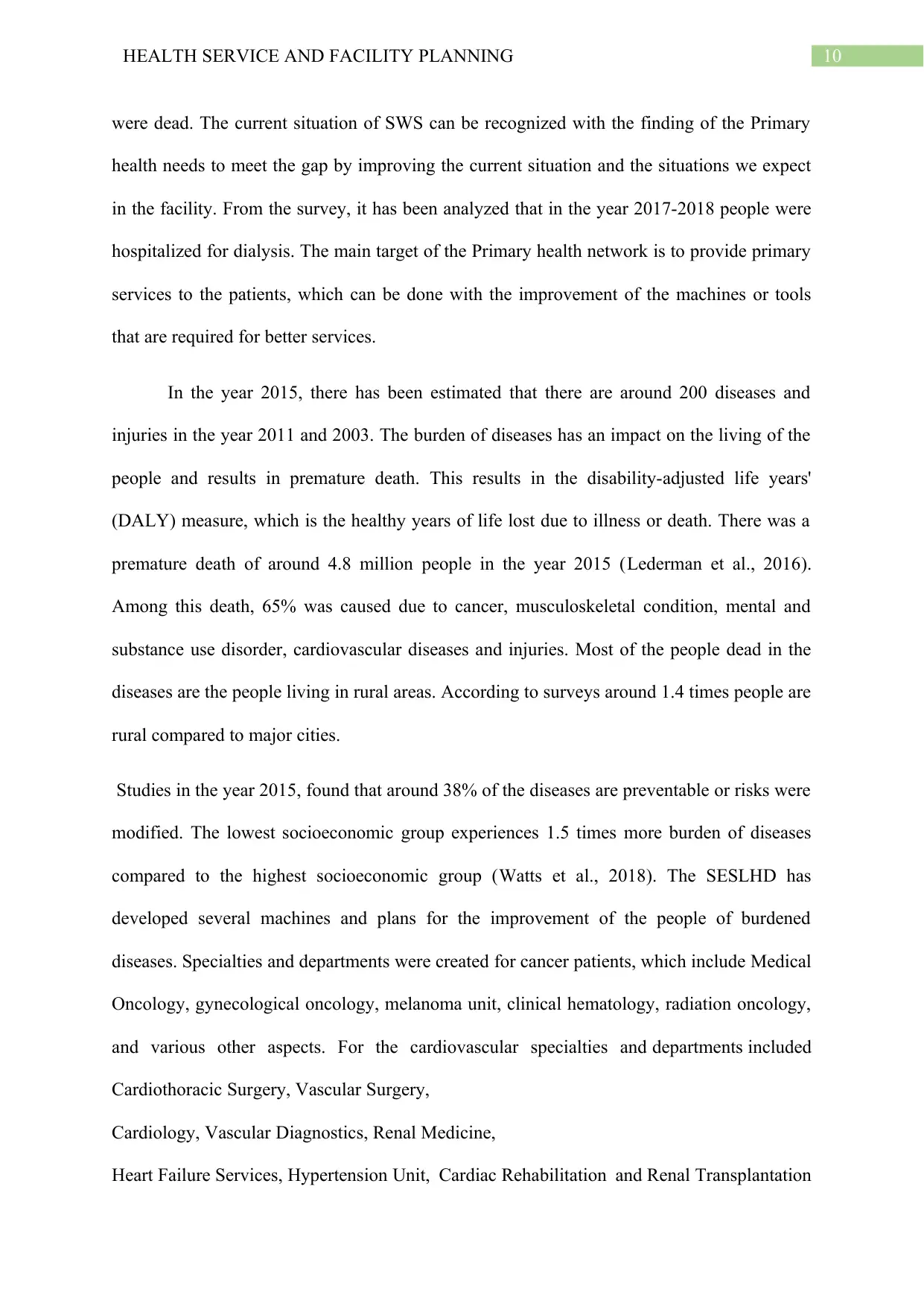
10HEALTH SERVICE AND FACILITY PLANNING
were dead. The current situation of SWS can be recognized with the finding of the Primary
health needs to meet the gap by improving the current situation and the situations we expect
in the facility. From the survey, it has been analyzed that in the year 2017-2018 people were
hospitalized for dialysis. The main target of the Primary health network is to provide primary
services to the patients, which can be done with the improvement of the machines or tools
that are required for better services.
In the year 2015, there has been estimated that there are around 200 diseases and
injuries in the year 2011 and 2003. The burden of diseases has an impact on the living of the
people and results in premature death. This results in the disability-adjusted life years'
(DALY) measure, which is the healthy years of life lost due to illness or death. There was a
premature death of around 4.8 million people in the year 2015 (Lederman et al., 2016).
Among this death, 65% was caused due to cancer, musculoskeletal condition, mental and
substance use disorder, cardiovascular diseases and injuries. Most of the people dead in the
diseases are the people living in rural areas. According to surveys around 1.4 times people are
rural compared to major cities.
Studies in the year 2015, found that around 38% of the diseases are preventable or risks were
modified. The lowest socioeconomic group experiences 1.5 times more burden of diseases
compared to the highest socioeconomic group (Watts et al., 2018). The SESLHD has
developed several machines and plans for the improvement of the people of burdened
diseases. Specialties and departments were created for cancer patients, which include Medical
Oncology, gynecological oncology, melanoma unit, clinical hematology, radiation oncology,
and various other aspects. For the cardiovascular specialties and departments included
Cardiothoracic Surgery, Vascular Surgery,
Cardiology, Vascular Diagnostics, Renal Medicine,
Heart Failure Services, Hypertension Unit, Cardiac Rehabilitation and Renal Transplantation
were dead. The current situation of SWS can be recognized with the finding of the Primary
health needs to meet the gap by improving the current situation and the situations we expect
in the facility. From the survey, it has been analyzed that in the year 2017-2018 people were
hospitalized for dialysis. The main target of the Primary health network is to provide primary
services to the patients, which can be done with the improvement of the machines or tools
that are required for better services.
In the year 2015, there has been estimated that there are around 200 diseases and
injuries in the year 2011 and 2003. The burden of diseases has an impact on the living of the
people and results in premature death. This results in the disability-adjusted life years'
(DALY) measure, which is the healthy years of life lost due to illness or death. There was a
premature death of around 4.8 million people in the year 2015 (Lederman et al., 2016).
Among this death, 65% was caused due to cancer, musculoskeletal condition, mental and
substance use disorder, cardiovascular diseases and injuries. Most of the people dead in the
diseases are the people living in rural areas. According to surveys around 1.4 times people are
rural compared to major cities.
Studies in the year 2015, found that around 38% of the diseases are preventable or risks were
modified. The lowest socioeconomic group experiences 1.5 times more burden of diseases
compared to the highest socioeconomic group (Watts et al., 2018). The SESLHD has
developed several machines and plans for the improvement of the people of burdened
diseases. Specialties and departments were created for cancer patients, which include Medical
Oncology, gynecological oncology, melanoma unit, clinical hematology, radiation oncology,
and various other aspects. For the cardiovascular specialties and departments included
Cardiothoracic Surgery, Vascular Surgery,
Cardiology, Vascular Diagnostics, Renal Medicine,
Heart Failure Services, Hypertension Unit, Cardiac Rehabilitation and Renal Transplantation
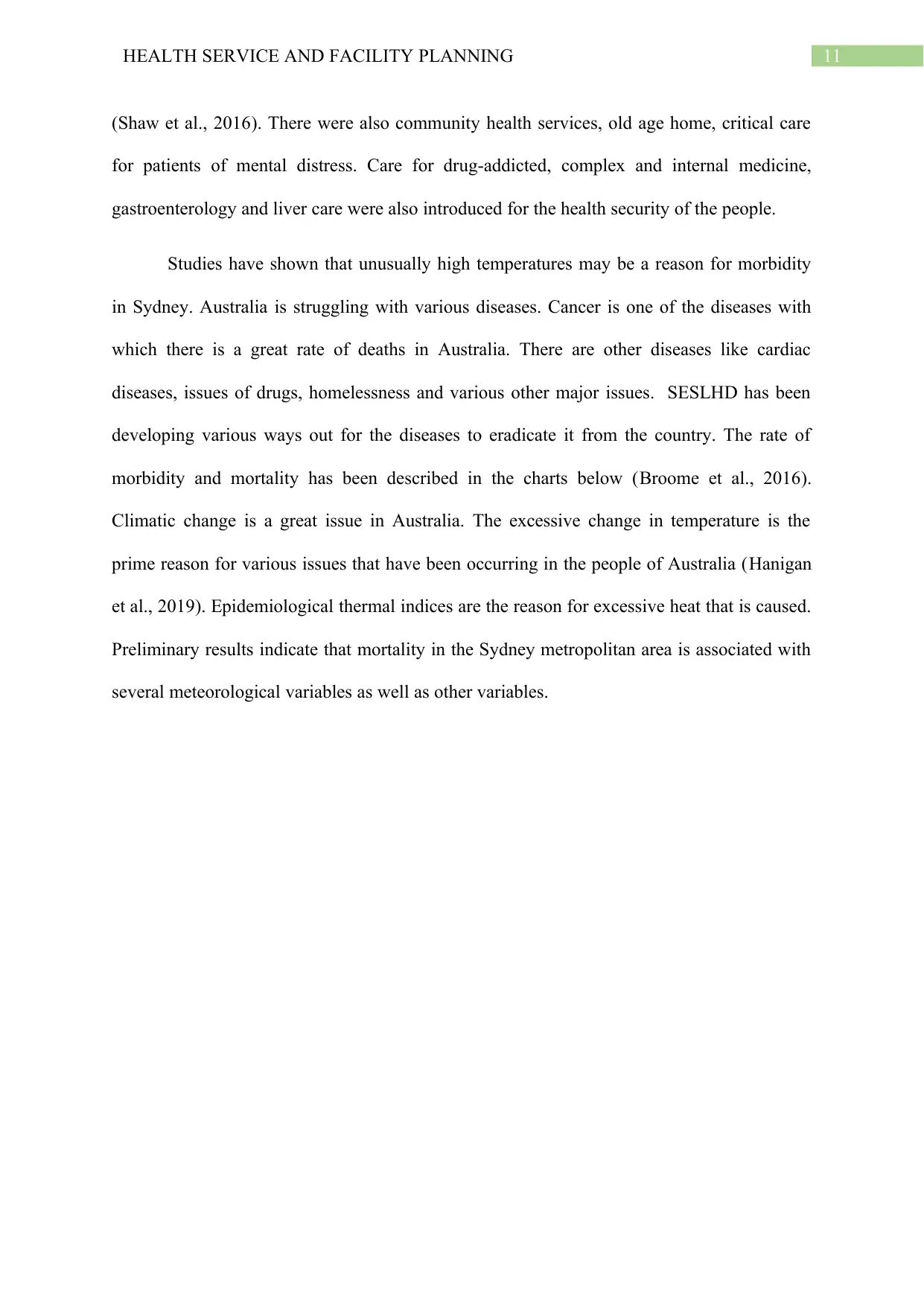
11HEALTH SERVICE AND FACILITY PLANNING
(Shaw et al., 2016). There were also community health services, old age home, critical care
for patients of mental distress. Care for drug-addicted, complex and internal medicine,
gastroenterology and liver care were also introduced for the health security of the people.
Studies have shown that unusually high temperatures may be a reason for morbidity
in Sydney. Australia is struggling with various diseases. Cancer is one of the diseases with
which there is a great rate of deaths in Australia. There are other diseases like cardiac
diseases, issues of drugs, homelessness and various other major issues. SESLHD has been
developing various ways out for the diseases to eradicate it from the country. The rate of
morbidity and mortality has been described in the charts below (Broome et al., 2016).
Climatic change is a great issue in Australia. The excessive change in temperature is the
prime reason for various issues that have been occurring in the people of Australia (Hanigan
et al., 2019). Epidemiological thermal indices are the reason for excessive heat that is caused.
Preliminary results indicate that mortality in the Sydney metropolitan area is associated with
several meteorological variables as well as other variables.
(Shaw et al., 2016). There were also community health services, old age home, critical care
for patients of mental distress. Care for drug-addicted, complex and internal medicine,
gastroenterology and liver care were also introduced for the health security of the people.
Studies have shown that unusually high temperatures may be a reason for morbidity
in Sydney. Australia is struggling with various diseases. Cancer is one of the diseases with
which there is a great rate of deaths in Australia. There are other diseases like cardiac
diseases, issues of drugs, homelessness and various other major issues. SESLHD has been
developing various ways out for the diseases to eradicate it from the country. The rate of
morbidity and mortality has been described in the charts below (Broome et al., 2016).
Climatic change is a great issue in Australia. The excessive change in temperature is the
prime reason for various issues that have been occurring in the people of Australia (Hanigan
et al., 2019). Epidemiological thermal indices are the reason for excessive heat that is caused.
Preliminary results indicate that mortality in the Sydney metropolitan area is associated with
several meteorological variables as well as other variables.
⊘ This is a preview!⊘
Do you want full access?
Subscribe today to unlock all pages.

Trusted by 1+ million students worldwide
1 out of 17
Related Documents
Your All-in-One AI-Powered Toolkit for Academic Success.
+13062052269
info@desklib.com
Available 24*7 on WhatsApp / Email
![[object Object]](/_next/static/media/star-bottom.7253800d.svg)
Unlock your academic potential
Copyright © 2020–2025 A2Z Services. All Rights Reserved. Developed and managed by ZUCOL.





